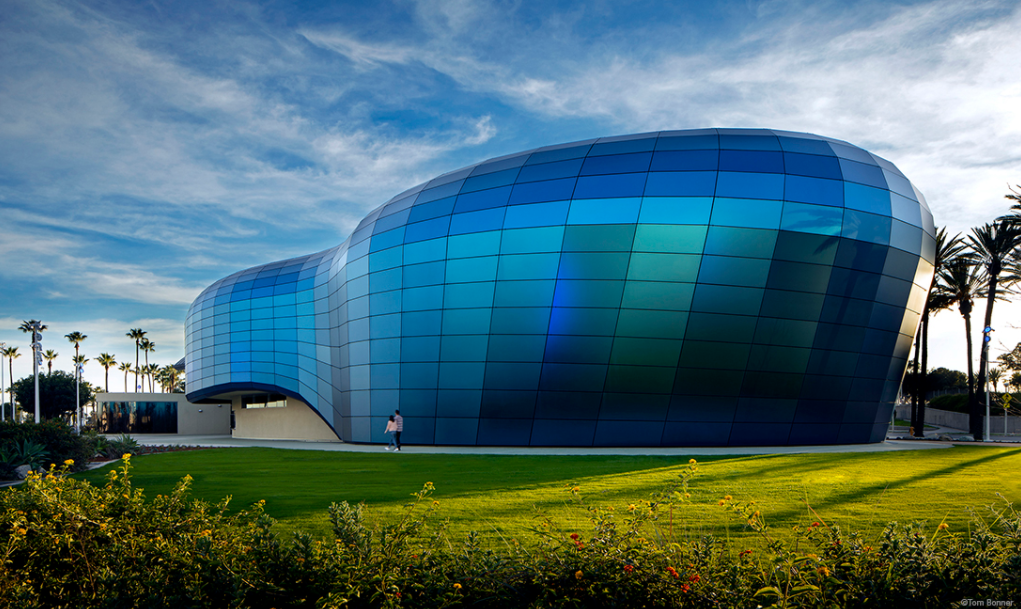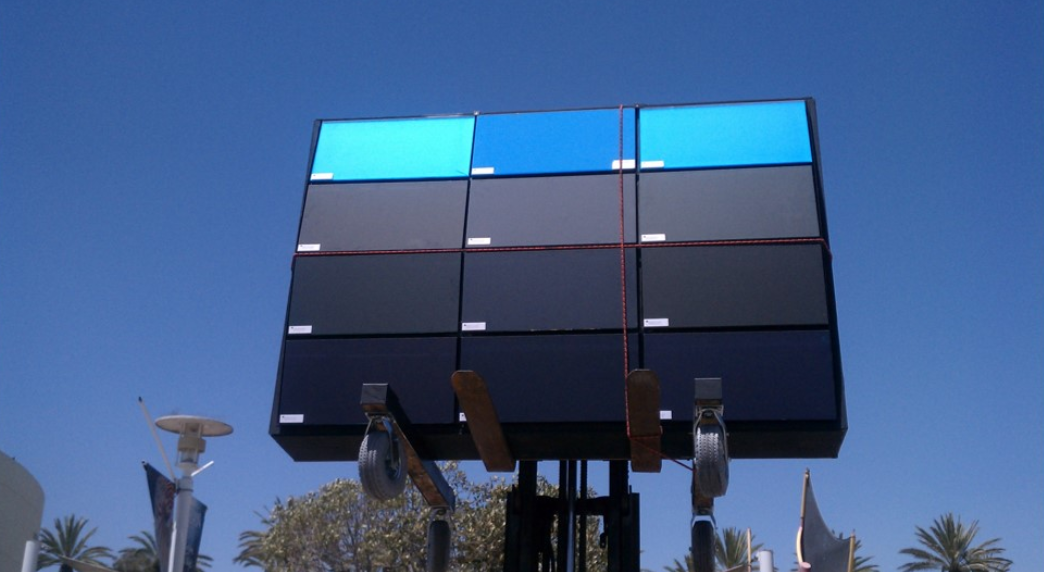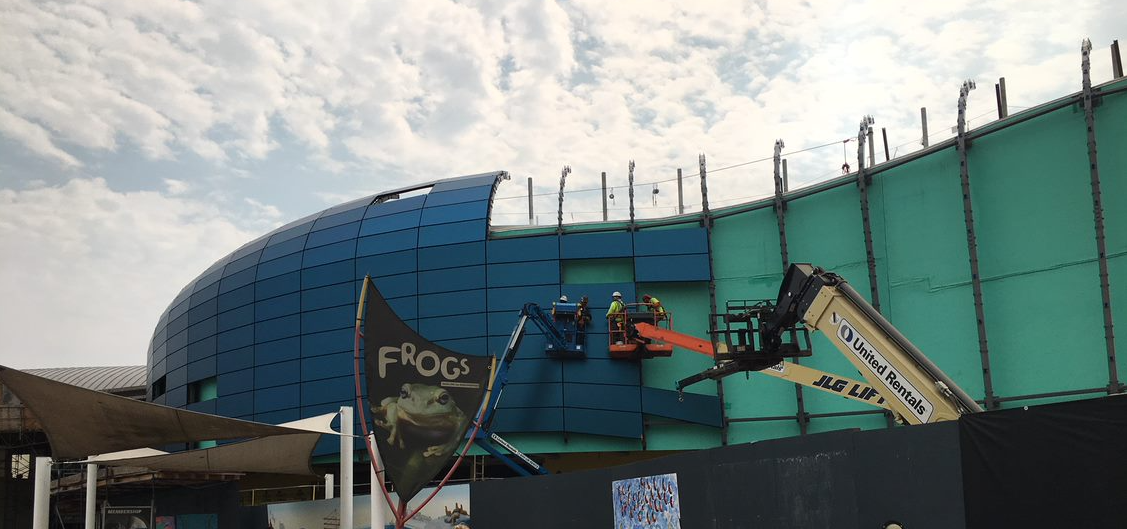
Engineered glazing systems offering visual transparency between interior and exterior spaces are typical installations of our SCGMA members, but as facades have evolved, so has the scope of work for these firms. In this SCGMA Case Study we look at a unique rainscreen wall at the new Pacific Visions Wing of the Aquarium of the Pacific in Long Beach, California.
A Mission of Engagement
The Aquarium of the Pacific’s mission is to engage visitors and to learn about our oceans, from the rich bio-diversity of the Pacific Ocean, from microscopic creatures to large sea creatures. Visitors can also explore today’s most important environmental issues.
Designed by San Francisco-based architecture firm EHDD, the new 29,000-sq-ft, two- story wing, represents the first major expansion by the Aquarium, serving as a focal point for the institution. Complementing the Aquarium’s existing building also designed by EHDD, the project’s façade responds to different daylight and weather conditions with varying colors to mirror the effect of sun rays bouncing on the ocean’s surface.
A Unique Façade Collaboration
With Buro Happold as the technical design team, each panel was uniquely sized with the help of Catia and Revit software to accommodate the curves and angles of the building’s form. The façade acts as a ventilated rain screen, is made up of 852 unique trapezoidal triple laminated light-diffusing glass panels weighing between 200 and 800 pounds and covers an area of 20,000 sq-ft.

“The interplay between form and material on the façade results in an “ever-shifting experience” where a visitor can observe a single color change as they move around the site at different times of day”, said Quyen Luong, EHDD design architect.
Duncan Ballash, president of EHDD, stated that the project required a lot of mock-ups, glazing assemblies, and experimentation to get the right effect on the glass so it would not have any reflections and to give it “some depth and luminosity and the feeling of the ocean.”

Delivery
The delivery of the new Pacific Visions Wing was through competitive bid from completed documents, with Clark Construction acting as the general contractor. Subcontract firms were prequalified prior to bid and following the contractor buyout process, Woodbridge Glass was awarded the project.
The Woodbridge Glass Contract Scope of Work included 20,000 sq. ft. of an exterior rain screen specialty glass cladding, exterior curtain wall to match the existing structure, interior specialty glass cladding (continuation from exterior to interior), various perforated/aluminum plate/SS mesh panel assemblies, as well as various transaction and conference room windows.
“Woodbridge Glass was extremely excited to be part of this project and for the opportunity to build such an iconic building”, said Trent Zinn, Woodbridge’s Project Manager. “We viewed this project as an opportunity to demonstrate our installation accuracy and skill. We knew from the beginning that layout and survey were going to be the most critical elements for success on this project. We dedicated two full time crews laying out every aspect of the building. The first crew shot the base building and imported these data points into the coordinated 3D model and then overlayed the points for clash detection. Our second crew was dedicated to shooting in and laying out all the vertical “Ribs” that supported our “cassette” window system. Our survey teams utilized a “Total Station” which allowed us to shoot points in real time space and import them into the model. Considering that the entire specialty glass cladding system was fabricated and built from this model, ensuring that our connection points correlated back to the contractual datum points was critical.”

Woodbridge Glass was fortunate to have partnered with great subcontractors and fabricators to successfully complete Pacific Visions. Sentech Architectural Systems designed and produced the fully functioning 3D model from which our scope of work was produced from. The effort and depth of this model was so that it showed every hole, notch, slot required in the model for system fabrication. It also produced glass fabrication drawings that we shared with Pulp Studios. Pulp Studios had a unique challenge by fabricating (3) individual pre-polished pcs of glass, then mating them together to form the 852 unique trapezoidal glass lites. Sentech Architectural Systems was also responsible for fabricating all the secondary steel components while Woodbridge Glass fabricated and installed all of the aluminum and glazing components. “The craftmanship and expertise of our subcontractors, fabricators and partners allowed for us to collectively have a very successful project”, said Trent Zinn.
The innermost layer of the façade incorporates a Mirropane glass with a ceramic opacifier on the 6th surface, the middle layer is Pacifica blue, and the outer layer is made of low-iron, Walker textured satin acid-etched glass, which eliminates direct reflection of the trees and sky to reduce the incidence of bird strikes.
The exterior specialty glass cladding system was supported by faceted structural HSS vertical members attached to the base building with mating base plates at 2 connections points per rib. Each vertical “Rib” had (4) connection arms for each window, thus equating to thousands of connection points for the building. The glazing “cassette” system was comprised of custom extrusions fabricated to form a picture frame to support each glass panel. Each panel was structurally glazed to the cassette frame and retained for dead load via a custom retainer clip. Each glass panel’s unique trapezoidal shape also required unique trapezoidal fabrication for the carrier frame of the cassette system and all its components. The entire façade was 100% fabricated from a coordinated, high-level BIM model. This BIM model was extracted and broken out into subsequent parts/units for fabrication, assembly, and glazing. Each unit was completely fabricated/assembled and glazed in the Woodbridge Glass plants and packaged/shipped in a sequence to support the left to right and bottom to top installation.
Unique Façade Challenges
“The biggest challenge presented from this one-of-a-kind façade design was the transformation of this theoretical design in space to reality”, said Trent Zinn. “The design team provided thousands of data points for where each corner of each glass panel was to land in space. The biggest challenge we encountered was laying out each vertical rib into a position to ensure that the build-up of clips/components supported the glass panels to hit the datum points provided by the design team. This specialty glass cladding façade was both concave and convex in elevation and serpentine in plan making the layout and survey efforts paramount.”
Installation of the panels began in July 2018 and at an October 2018 event, crews for Woodbridge Glass lifted the last panel of glass by hand from boom lifts and secured it in place by hanging the carrier frame on 4 brackets attached to the secondary support steel and engaging a seismic clip.
Lessons Learned
“As in any project, your success is deeply connected with the partners you select to form your project team. Pacific Visions demonstrated this fact more than any other project we have been on” said Trent Zinn. “Additionally, our fabrication plant has made enormous efforts recently to upgrade and revamp our fabrication drawing process so that our CNC machines in our shop can fabricate directly from a model. This new age approach reduces human error by eliminating the transfer of fabrication information from 2D drawings into fabrication documents. Our software allows us to pull in the 3D model and convert it into fabrication documents with extreme accuracy. Without having this software in place prior to Pacific Visions we could never have fabricated these unique trapezoidal glass panels to the level of accuracy required to achieve such a demanding design.”
Acknowledgements / Awards
Project – Pacific Visions at the Aquarium of the Pacific
Architect – EHDD Architects, Duncan Ballash, Quyen Luong, Ron Elad and Buro Happold
Contractor – Clark Construction
Façade Contractor – Woodbridge Glass
- Woodbridge Glass assembled one of our strongest internal teams for the Pacific Visions project. This team was assembled based on past experiences with BIM projects as well unique and custom structural glass wall projects. Team includes:
- Steve Siciliani – Project Executive and Principal
- Trent Zinn– Project Manager
- Eddie Gonzalez – Project Manager
- James Pascual – Werner Systems Design Manager and BIM Coordinator
- Joe Kennedy – Superintendent
- Steve Wells – Field Survey Foreman
- Ricardo Vargas – Fabrication Plant Manager
- Mario Vargas – Assembly and Glazing Plant Manager
Award – Los Angeles Business Journal Commercial Real Estate Award “Gold Award”
SCGMA represents a large variety of glazing firms with decades of experience and special talents for finding solutions on the most complex projects. Contact SCGMA to see how our members could provide assistance on your project.
